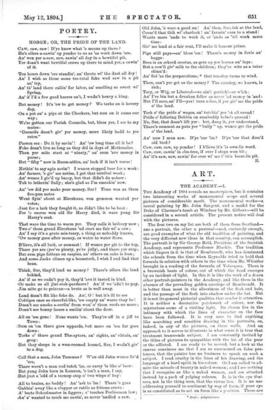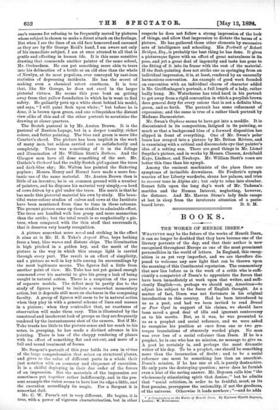ART.
THE ACADEMY.—I.
THE Academy of 1894 reveals no masterpiece, but it contains two interesting works of monumental scope and several pictures of considerable merit. The monumental works—a mural painting by Mr. John Sargent, and a model for the Duke of Clarence's tomb at Windsor by Mr. Gilbert—will be considered in a second article. The present notice will deal with the pictures.
The first two on my list are both of them from Scotland— one a portrait, the other a pastoral—and, curiously enough, are good examples of what the old tradition of painting, and the very different new ideas in that country, can accomplish. The portrait is by Sir George Reid, President of the Scottish Academy, and represents Professor Blackie. The tradition which lingers in it is that of Rembrandt, who has dominated the schools from the time when Reynolds tried to hold that formula in solution with others to the time when Mr. Whistler brought in a reading of the formula of Velasquez. There is a brownish basis of colour, out of which the head emerges by an incident of light. In this it is like the work of a dozen other portrait-painters in the Academy, and like them in the absence of the pervading golden envelope of Rembrandt. It is better than most in the silveriness of the flesh and hair, and the passage of the flesh into shadow under the hat. But it is not its general pictorial qualities that render it attractive.
It is neither a decorative patchwork of colour, nor the mysterious scene of a visiting light. Its charm lies in the intimacy with which the lines of character on the face have been followed. It is very rare to find anything like searching and sensitive drawing in the portraits, or, indeed, in any of the pictures, on these walls. And an approach to it serves to illustrate in what sense it is true that treatment transcends subject. I ant constantly invited by the titles of pictures to sympathise with the lot of the poor or the afflicted. I am ready to be moved, but a look at the
canvas convinces me that I am so summoned on false pre- tences, that the painter has no business to speak on such a
subject. I read cruelty in the lines of his drawing, and the language of a hard spirit in his colour. Or I am called to ad- mire the miracle of beauty in naked woman ; and I see nothing that I recognise as like a naked woman, and am attacked instead by a pack of yelping colours. It is in the eye that sees, not in the thing seen, that the virtue lies. It is no use addressing yourself to sentiment by way of form, if your eye is so constituted as to act on form like a poultice. These are
• Atigl.: palpitAtions.
one's reasons for refusing to be frequently moved by pictures whose subject is chosen to make a direct attack on the feelings. But when I see the lines of an old face honoured and caressed as they are by Sir George Reid'a hand, I am aware not only of his immediate subject, I am at once attuned to all that is gentle and affecting in human life. It is this same sensitive drawing that commends another painter of the same school, Mr. Orchardson. He can put something more akin to tears into his delineation of a bottle or an old shoe than the whole of Newlyn, at its most populous, ever conveyed by east-iron statistics of depressing incidents. He has the secret of making even a chemical retort courteous. It is true that, like Sir George, he does not excel in the larger pictorial virtues. He seems this year bent on getting away from that yellow foundation in which he is wont to find safety. He gallantly puts up a white sheet behind his model, and says, "I will paint flesh upon white ; " but before he is done, it is brown upon green, and one relinquishes the distant view alike of this and of the other portrait to scrutinise the drawing at closer quarters.
The Scotch pastoral is by Mr. Austen Brown. It is the pastoral of Bastien-Lepage, but in a deeper tonality, richer colour, and fatter painting. The blue and green is more like Courbet's chord. The picture has been implicit in the work of many men, but seldom carried out so satisfactorily and completely. There was something of it in the foliage and illumination of Mr. William Stott's Bathers. And the Glasgow men have all done something of the sort. Mr. Gtithrie's Orchard had the ruddy Scotch girl against the trees and dark-blue sky; Mr. Walton has painted the flickering poplars ; Messrs. Henry and Hornel have made a more fan- tastic use of the same material. Mr. Austen Brown then is little of an inventor, he is on common ground with a number of painters, and he disposes his material very simply,—a herd of cows driven by a girl under the trees. His merit is that he has made this pictorial material his own by study. His beau- tiful water-colour studies of calves and cows at the Institute have been mentioned from time to time in these columns. The present picture sums up these studies to admirable effect. The trees are handled with less grasp and more mannerism than the cattle; but the total result is so emphatically a pic- ture, when compared with the thin stuff that surrounds it, that it deserves very hearty recognition.
A picture somewhat more no el and striking in the effect it aims at is Mr. H. S. Take's August Blue, boys bathing from a boat, blue waves and distant ships. The illumination is high pitched in a golden key, and the merit of the picture is the way in which this orange light is carried through every part. The result is an effect of simplicity, and a picture so well in key tells among its surroundings by the most legitimate means. The figures fail a little from another point of view. Mr. Take has not yet gained enough command over his material to give his group a look of being caught in natural action. There is a suspicion of the pose of separate models. The defect may be partly due to the study of figures posed to imitate a somewhat momentary action, but it depends still more on slackness in the composing faculty. A group of figures will seem to be in natural action when they play in with a general scheme of lines and masses in a picture; when they contradict that, no exactness of observation will make them easy. This is illustrated by the unnatural and incoherent look of groups as they are frequently rendered by the instantaneous shot of the camera. But if Mr. Take trusts too little to the picture-sense and too much to his notes, in grouping, he has made a distinct advance in his painting. There is less of the choppy rendering of planes with its effect of something flat and cut-out, and more of a full and round treatment of forms.
Mr. Sargent's portrait of this year holds its own in vi”tue of the large comprehension that seizes on structural planes, and gives to the value of different parts in a whole their just notation with an economy and eloquence of execution. It is a skilful deploying in their due order of the forces of an impression. But the materials of the impression are sometimes put together rather indifferently, and in the pre- sent example the vision seems to have lost its edge a little, and the execution accordingly its magic. For a Sargent it is somewhat dull.
Mr. C. W. Furse's art is very different. He begins, it is true, with a power of vigorous characterisation, but in other
respects he does not follow a strong impression of the look of things, and allow that impression to dictate the terms of a 'picture. He has gathered these other elements by successive- acts of intelligence and schooling. His Portrait of Robert Bridges, Esq., is probably the best thing he has done. It gives a picturesque figure with an effect of great naturalness in its pose, and yet a great deal of ingenuity and taste has gone to the fitting of it into its frame with the rest of the material._ If the flesh-painting does not strike one as springing from an- individual impression, it is, at least, rendered by an unusually harmonious convention. An example of good work founded' on convention with an individual charm of character added is Mr. Greiffenhagen's portrait, a fall length of a lady, rather- badly hung. Mr. Waterhouse has tried hard in his portrait to get away from a rigid convention in which a purplish brown does general duty for every colour that is not a definite blue, green, and so forth. The portrait has some refinement of expression; and the same is true of a rather black portrait by Madame Darmesteter.
Mr. Swan's Orpheus seems to have got into a muddle. It is discontented in its composition, fatigued in its painting, so. much so that a background blue of a forward disposition has slipped in front of everything. One of Mr. Swan's polar- bears has strayed into a picture by Mr. Briton Riviere, and is examining with a critical and disconsolate eye that painter's idea of a setting sun. There are good things in Mr. Lionel! Smythe's picture, and in works by Messrs. Clausen, Archibald Kaye, Lindner, and Neuhuys. Mr. William Stott's roses are better this time than his nymph.
Among the eminent machinists of the place there are- symptoms of invincible drowsiness. Sir Frederic's nymph wearies of her Liberty wardrobe, shuns her palaces, and tries to recover tone in Alpine air; but only to relax into slumber. Sunset falls upon the long day's work of Mr. Tadema's- marbles and the Human Interest, neglecting, however, the distance. And Mr. Marcus Stone's lady finds escape at last in sleep from the inveterate attention of a paste- board lover. D. S. M.



































 Previous page
Previous page